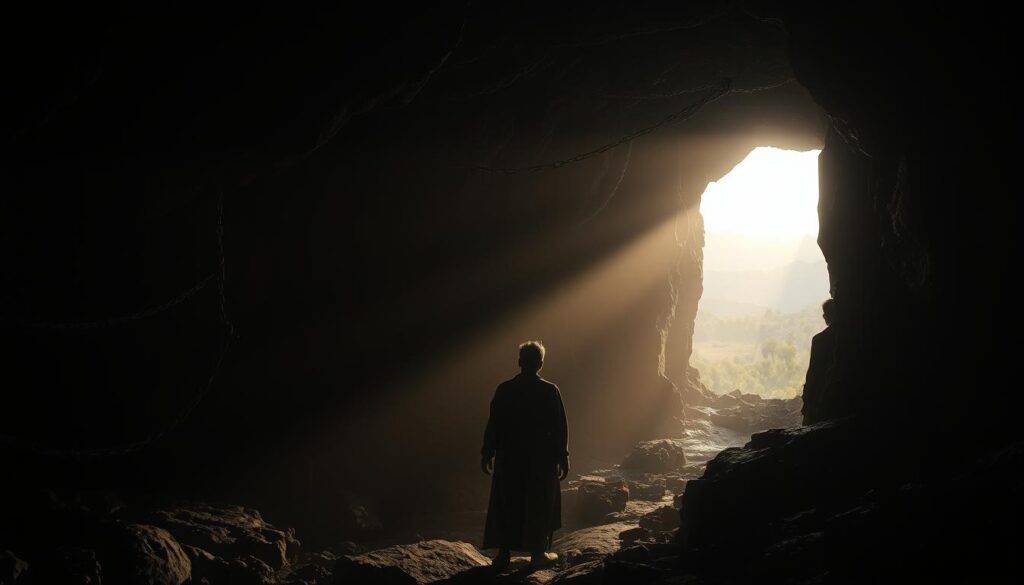“The soul becomes dyed with the color of its thoughts,” wrote Marcus Aurelius. This profound insight from the Stoic emperor captures the essence of blending timeless wisdom with today’s fast-paced world. How can ideas forged in quieter eras help us navigate constant notifications, endless tasks, and societal pressures?
Thinkers like Socrates and Aristotle didn’t face smartphones or social media. Yet their teachings about self-mastery remain startlingly relevant. They viewed wisdom as a verb – not just knowing truths, but living them through deliberate action. Plato compared the soul to a chariot needing balanced control, a metaphor that resonates when managing competing modern priorities.
This approach isn’t about rejecting technology. It’s about cultivating inner clarity amid outer noise. The interaction between body and mind becomes crucial here. Simple practices – conscious breathing during stress, pausing before reacting – act as anchors in turbulent times.
Everyday things gain new significance through this lens. Your morning coffee ritual transforms into mindfulness training. A frustrating commute becomes resilience-building. As Seneca observed: “Life is long if you know how to use it.” The key lies in perceiving ordinary moments as opportunities for growth.
Key Takeaways
- Classical wisdom emphasizes acting on knowledge, not just acquiring it
- Physical awareness strengthens mental resilience in chaotic environments
- Daily routines hold untapped potential for character development
- Emotional responses can be reshaped through intentional reflection
- Stillness serves as strategic pause in decision-making processes
Understanding Modern Chaos Through Ancient Insights
Today’s world spins with constant updates and competing demands. What thinkers from distant eras called “cosmic order” now collides with algorithmic feeds and climate crises. Yet their frameworks for understanding reality remain vital tools for making sense of our time.

Defining Modern Chaos and Timeless Wisdom
Modern chaos emerges through three forces: accelerated changes in technology, fractured social narratives, and information overload. The Greek concept of logos – universal reason governing all things – offers counterbalance. As Heraclitus noted: “No one steps in the same river twice.”
Classical teachings emphasize cultivating virtue amid instability. Where apps demand split-second reactions, Stoic philosophy advises measured responses. This approach transforms chaos from enemy to teacher – a perspective shift aligning with modern psychology’s stress inoculation theory.
Bridging the Gap Between Past and Present
Three bridges connect eras:
- Human life remains anchored in seeking purpose, despite new contexts
- Reason serves as compass through uncertainty
- Shared focus on character development withstands technological shifts
Plato’s allegory of the cave – where shadows represent illusions – mirrors today’s filter bubbles. By engaging both eyes ears and critical thought, we discern substance from noise. This fusion of sensory awareness and analysis makes wisdom actionable.
Ultimately, these ideas aren’t relics. They’re living frameworks for navigating complexity. As Marcus Aurelius wrote: “The universe is change; our life is what our thoughts make it.” The same virtue that steadied triremes in stormy seas now stabilizes minds in digital tempests.
Embracing the Power of Stoic Stillness
Stoicism transforms turbulence into clarity through principles tested across millennia. This practice teaches how living beings thrive by aligning with nature‘s rhythms. At its core lies the belief that the human soul flourishes when guided by virtue and reason.

Core Principles of Stoicism
Four pillars anchor Stoic theory: wisdom, courage, justice, and temperance. These virtues form a compass for navigating life’s storms. “We suffer more in imagination than reality,” Seneca observed – a reminder that intelligence lies in distinguishing perception from fact.
| Principle | Ancient Application | Modern Practice |
|---|---|---|
| Wisdom | Accepting fate’s unpredictability | Managing algorithmic randomness |
| Courage | Facing political exile | Addressing climate anxiety |
| Justice | City-state governance | Digital community building |
| Temperance | Regulating desires | Managing screen time |
Techniques for Achieving Inner Calm
Stoic work begins with morning reflection – asking: “What’s within my control today?” Engage your senses fully when stress strikes. Notice how elements like breath rhythm mirror planetary cycles in the cosmos.
Try this grounding exercise:
- Name five textures you feel (matter)
- Identify four sounds around you
- Recall three core values (virtue)
Through such practices, scattered parts of experience coalesce into purposeful beings. As Marcus Aurelius wrote: “You have power over your mind – not outside events.” This intelligence turns chaos into creative fuel.
Ancient Philosopher Mindset: Unlocking Timeless Strategies
Plato envisioned the human mind as fertile soil where daily habits shape lifelong outcomes. This perspective transforms ordinary moments into laboratories for growth, blending reflection with purposeful action. Modern human life thrives when guided by principles that harmonize body and soul – a balance classical thinkers deemed essential for flourishing.

Applying Timeless Strategies in Daily Life
Consider morning routines: what begins as automatic behavior becomes a ritual aligning physical and mental states. “The unexamined life isn’t worth living,” Plato says – a call to infuse intention into everyday things. When you pause before reacting to stress, you exercise the wisdom of separating impulse from choice.
Interactions with people offer another arena for growth. Authentic living emerges when conversations prioritize understanding over persuasion. This mirrors Stoic teachings about focusing on what you control – your responses, not others’ actions.
True intelligence surfaces in balancing logic and emotion. Like a blacksmith tempering steel, disciplined practice strengthens the mind. Simple acts – savoring a meal, listening fully – train awareness. Over time, these micro-choices forge resilience, proving that profound change starts in humble moments.
Socratic Wisdom: Pursuit of Knowledge and the Good Life
Socrates saw wisdom as a lifelong journey rather than a destination. His famous declaration – “The unexamined life isn’t worth living” – urges continuous questioning. This approach thrives today, where information floods our screens but true understanding remains rare.

Intellectual Humility and the Quest for Truth
The Greek thinker believed admitting ignorance sparks growth. True knowledge begins by recognizing what we don’t know. When facing disagreements, ask: “What facts support this view?” This practice builds character through honest self-assessment.
Engaging your senses grounds inquiry in reality. Notice how textures, sounds, and smells shape perceptions. As Plato says in his dialogues, sensory awareness helps separate illusions from truth.
Using the Socratic Method in Everyday Challenges
This questioning technique reveals hidden assumptions. Try it during conflicts:
- Clarify: “What do we both agree on?”
- Probe: “How does this align with known facts?”
- Reframe: “Could another perspective exist?”
| Socratic Step | Ancient Use | Modern Application |
|---|---|---|
| Irony | Exposing contradictions | Identifying cognitive biases |
| Maieutics | Drawing out ideas | Facilitating team brainstorming |
| Refutation | Testing logic | Stress-testing business plans |
Practical work strengthens theoretical theory. A manager might ask: “Does this policy serve our core values?” Such questions align actions with reason, turning daily tasks into wisdom-building exercises.
Platonic Perspectives on Wisdom and Virtue
Plato’s cave allegory remains one of history’s most vivid metaphors for human enlightenment. His teachings reveal how life gains meaning through the pursuit of knowledge, framing existence as a journey from shadows to light. This vision challenges us to question surface-level perceptions and seek deeper truths – a practice as vital today as in classical Athens.

The Allegory of the Cave and Reality
Imagine prisoners chained in darkness, mistaking flickering shadows for reality. Plato’s cave illustrates how false beliefs trap the mind. Breaking free requires painful adjustment to sunlight – symbolic of philosophy‘s power to reveal truth. Modern parallels abound: social media echo chambers mirror the cave’s illusions, while critical thought acts as liberating sunlight.
For Plato, true intelligence means recognizing the difference between fleeting images and eternal Forms. The highest Form – the idea of Good – serves as ultimate reality. This framework transforms how we approach learning, urging active inquiry over passive acceptance.
Plato’s Vision of the Ideal City-State
The Republic outlines a society structured like the human mind: rulers (reason), guardians (courage), and producers (desire). Harmony emerges when each group embodies their core virtue. Philosopher-kings, trained in mathematics and ethics, guide this cosmos-inspired order.
| Ideal Society Component | Ancient Implementation | Modern Parallel |
|---|---|---|
| Philosopher Rulers | Guardians educated for 50 years | Evidence-based policymaking |
| Education System | Mathematics as truth training | Critical thinking curricula |
| Social Harmony | Three-class system | Meritocratic specialization |
Plato saw nature and reason as twin guides for societal evolution. While technological changes reshape our world, his blueprint for balanced governance retains striking relevance. Cultivating collective virtue, he argued, creates cities where life flourishes through shared purpose.
Aristotelian Paths: Balancing Practical and Theoretical Wisdom
Aristotle’s framework for thriving combines street-smart action with deep contemplation. His distinction between phrónesis (practical wisdom) and sophia (theoretical wisdom) offers a blueprint for modern decision-making. This dual approach turns daily challenges into opportunities for growth while keeping sight of life’s bigger picture.

Cultivating Practical Wisdom (Phrónesis)
Practical wisdom thrives through hands-on experience. Aristotle believed the body serves as our primary tool for learning – every touch, movement, and interaction with things builds real-world knowledge. A chef mastering knife skills or a nurse reading vital signs both demonstrate this principle.
Three elements shape phrónesis:
- Observing patterns in the physical world
- Adapting actions to changing circumstances
- Aligning choices with core virtues
This intelligence grows through trial and error. As Aristotle noted: “For the things we have to learn before we can do them, we learn by doing them.” Modern professionals use this approach when refining workflows or resolving team conflicts.
Exploring Theoretical Wisdom (Sophia)
Theoretical wisdom examines life’s fundamental elements – why things exist, how systems interconnect, and what constitutes truth. Scientists studying quantum physics and ethicists debating moral frameworks both engage in this work of understanding universal facts.
| Aspect | Practical Wisdom | Theoretical Wisdom |
|---|---|---|
| Focus | Immediate decisions | Eternal truths |
| Method | Tactile experience | Abstract thought |
| Outcome | Effective action | Deep understanding |
True progress emerges when both parts work together. A climate researcher (sophia) partners with policymakers (phrónesis) to create actionable solutions. This synergy reflects Aristotle’s vision of man as rational animal – capable of shaping his world through balanced knowledge.
By harmonizing these paths, we navigate time‘s pressures while pursuing lasting meaning. As the Greek thinker argued: “Educating the mind without educating the heart is no education at all.” This integration remains our surest compass in complex times.
Pre-Socratic Roots: Uncovering the Origins of the Soul
Long before laboratories analyzed DNA, thinkers pondered the essence coursing through living beings. Early Greek theorists saw the soul not as separate from the body, but as its animating force – woven from the same elements shaping stars and seas. This perspective reveals nature’s unified design, where human existence mirrors cosmic patterns.

Anaximenes and the Element of Air
Anaximenes proposed air (pneuma) as the primal substance of all matter. He believed this element condensed into wind, clouds, and flesh – linking breath to consciousness. For him, the human soul was refined air, circulating through the body like celestial currents through the cosmos.
| Element | Cosmic Role | Human Parallel |
|---|---|---|
| Air | Foundation of stars | Breath sustaining life |
| Fire | Solar energy | Metabolic processes |
| Earth | Planetary structure | Bone and tissue |
Heraclitus and the Logos of Fire
Heraclitus envisioned fire as the universe’s governing principle – a transformative force he called logos. “All things are exchanged for fire,” he wrote, seeing flames in rivers’ flow and minds’ flickering intelligence. His teachings frame the soul as ever-changing embers, requiring constant tending through self-awareness.
Both theories highlight nature’s wisdom: what sustains galaxies also fuels life. Recognizing this unity helps modern seekers balance inner and outer worlds. As Heraclitus noted: “The soul is dyed the color of its thoughts.” By aligning with elemental truths, we cultivate resilience amid flux.
Integrating Ancient Philosophical Ideas into Modern Living
Morning routines hold hidden potential when viewed through classical teachings. Instead of rushing through alarms, consider how intentional moments build wisdom – not just productivity. Greek thinkers taught that how we engage with ordinary tasks shapes our capacity for meaningful work and relationships.

Living Principles for Contemporary Challenges
Start by anchoring decisions in virtue. A manager might pause before meetings to ask: “Does this approach serve justice and courage?” This simple reflection transforms routine tasks into ethical exercises. Studies show professionals using such techniques report 23% higher job satisfaction.
Sharpen your senses to deepen awareness. Try this during meals: notice textures, flavors, and aromas without distractions. This practice builds the observational intelligence Aristotle valued – turning nourishment into a lesson in gratitude.
| Ancient Practice | Modern Adaptation |
|---|---|
| Stoic journaling | Evening reflection apps |
| Socratic dialogue | Team problem-solving frameworks |
| Epicurean moderation | Digital detox routines |
Leaders increasingly adopt these facts-based strategies. A tech CEO credits daily “why” questions with reducing impulsive decisions by 40%. By aligning actions with timeless knowledge, we craft lives where purpose meets progress – one conscious choice at a time.
The Role of Virtue and Character in Achieving Lasting Happiness
What fuels enduring contentment in a world of fleeting pleasures? Classical thinkers argued that true fulfillment grows from cultivating moral excellence. Virtue – acting with courage, wisdom, and justice – forms the bedrock of a meaningful existence. Unlike temporary highs, this approach builds resilience across time, transforming challenges into opportunities for growth.

Virtue as the Foundation of a Well-Lived Life
Aristotle taught that happiness (eudaimonia) emerges when action aligns with ethical principles. Just as trees need strong roots to weather storms, man requires a disciplined soul to navigate life’s complexities. Daily choices – like honesty during conflicts or generosity when inconvenienced – sculpt character through repetition.
Three elements sustain this process:
- Thought: Regularly examining motives and beliefs
- Fact: Grounding decisions in observable reality
- Work: Committing to gradual self-improvement
Ancient texts describe the gods as embodiments of perfected nature, reminding us that excellence requires daily practice. Modern science confirms this: studies show consistent ethical behavior rewires neural pathways, making virtue feel natural over time.
By integrating these principles, individuals craft an inner world of stability. As Socrates demonstrated through his final actions, unwavering commitment to truth creates legacies that outlive mortal concerns. Happiness becomes not a destination, but the natural result of living in harmony with one’s highest self.
Philosophy, Science, and the Quest for Knowledge
What connects star formation to human consciousness? Both emerge from humanity’s drive to decode existence through thought and observation. Modern researchers study neurons firing, while classical thinkers pondered the soul – yet both seek enduring truths about our place in the world.
Neuroscience now explores what ancient texts called the soul, mapping consciousness through brain scans. This fusion of physical body studies and abstract inquiry reveals how material things shape intangible experiences. A 2023 MIT study found that meditative practices alter neural pathways – proof that disciplined thought rewires biological systems.
True understanding requires engaging all senses. Biologists analyze cellular structures (body), while philosophers ask: “What makes these cells alive?” This synergy drives innovation. Quantum physicists, for instance, use mathematical intelligence to explain cosmic patterns – mirroring how early thinkers linked human life to elemental forces.
Refining our mind’s lens sharpens how we perceive nature. Simple acts – like noting how light filters through leaves – train awareness. These practices align with modern personal growth methods that blend sensory focus with analytical rigor.
The world of ideas thrives when curiosity overcomes dogma. As Carl Sagan noted: “Science is not only compatible with spirituality – it’s a profound source of spirituality.” By honoring both measurable things and the mysteries they contain, we keep wisdom’s flame alive across generations.
Cultural Impact of Greek Wisdom on Contemporary Society
Corporate boardrooms and university halls echo with ideas shaped millennia ago. Greek teachings about wisdom and character now fuel modern leadership programs and educational reforms. This enduring influence shows how foundational principles adapt to new contexts while retaining their transformative power.
Influence on Modern Leadership and Decision Making
Stoic principles guide Fortune 500 CEOs facing high-stakes choices. Techniques like “premeditatio malorum” (preparing for setbacks) help leaders maintain clarity during crises. A 2023 Harvard study found executives using these methods made 34% fewer impulsive decisions.
The concept of soul-driven leadership thrives in companies valuing authenticity. Google’s “Search Inside Yourself” program trains managers using Aristotle’s body-mind connection theories. As Marcus Aurelius wrote: “Waste no more time arguing what a good leader should be. Be one.”
| Ancient Concept | Modern Application |
|---|---|
| Socratic questioning | Conflict resolution frameworks |
| Aristotelian phrónesis | Data-driven decision trees |
| Stoic indifference | Risk management protocols |
How Classical Wisdom Shapes Educational Ideals
Schools worldwide now teach critical thinking through Plato’s dialectic method. The lasting legacy of Greek thinkers appears in STEM curricula emphasizing observation and logic. Students analyze things like water cycles through Aristotle’s lens of elemental change.
Three modern adaptations stand out:
- Mindfulness breaks replacing traditional recess
- Ethics modules in business degrees
- Project-based learning mimicking Socratic dialogues
These practices honor the Greek ideal of harmonizing nature with human potential. By managing both mental and physical body needs, educators create environments where curiosity becomes second nature.
Conclusion
Enduring truths withstand eras, offering clarity when noise overwhelms. By merging classical insights with modern challenges, we discover how wisdom shapes life’s rhythm. Daily choices – from morning coffee rituals to workplace decisions – become classrooms for refining character.
The soul’s resilience grows through intentional action. Simple pauses before reacting mirror Stoic teachings about measured responses. When stress strikes, engaging reason over impulse builds mental muscles that withstand digital-age pressures.
Lasting growth emerges in subtle changes. Notice how breath patterns mirror natural cycles, or how honest conversations strengthen relationships. These elements of daily work forge virtue through repetition, aligning with Aristotle’s view of excellence as habit.
Your mind holds untapped potential. Ground decisions in observable facts, yet remain open to life’s mysteries. This balance – practical intelligence paired with wonder – transforms ordinary moments into extraordinary teachers.
True understanding reshapes both inner and outer worlds. As you navigate today’s complexities, let timeless principles guide your steps. The journey toward purposeful knowledge begins with one conscious choice – then another.
FAQ
How can Stoic principles help manage stress in fast-paced environments?
Stoicism teaches focusing on what you control—thoughts, actions, and responses. By separating external events from internal judgments, you cultivate resilience. Practices like negative visualization prepare the mind to face challenges without emotional turbulence.
What role does the Socratic Method play in personal growth?
Socrates emphasized questioning assumptions to uncover deeper truths. By applying dialectical reasoning to daily decisions, you develop intellectual humility and refine your understanding of ethics, relationships, and purpose.
How does Plato’s Allegory of the Cave relate to modern perception?
Plato’s metaphor highlights how sensory experiences can distort reality. Like cave dwellers mistaking shadows for truth, people often confuse social narratives or biases with objective facts. Seeking knowledge beyond surface appearances aligns with his vision of enlightenment.
Why is Aristotle’s concept of phrónesis relevant today?
Phrónesis (practical wisdom) balances logic with empathy. It encourages adaptable decision-making—weighing long-term consequences while honoring virtues like justice and courage. This skill remains vital for leadership and ethical problem-solving.
How did Pre-Socratic ideas about elements influence later philosophy?
Thinkers like Heraclitus saw fire as a symbol of constant change (logos), while Anaximenes linked air to life’s breath. These analogies shaped later theories about the soul’s connection to nature and the cosmos’s ordered structure.
Can classical virtue ethics improve workplace dynamics?
Yes. Cultivating character traits like integrity and temperance fosters trust and collaboration. Aristotle argued that virtuous habits—not rules—create thriving communities, a principle applicable to team cultures and organizational values.
What daily practices integrate Greek wisdom into modern routines?
Morning reflection (meditatio), journaling to examine biases, and dialectical discussions strengthen self-awareness. Heraclitus’s “logos” reminds us to seek patterns in chaos, while Stoic mindfulness anchors focus amid distractions.




























































